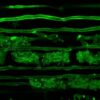The LIGO/Virgo/KAGRA Collaboration, a large group of researchers at different institutes worldwide, has recently set the strongest constraints on cosmic strings to date, using the Advanced LIGO/Virgo full O3 dataset. This dataset contains the latest gravitational waves data detected by a network of three interferometers located in United States and in Italy.
“We wanted to use the most current data of the third observing run (O3 dataset) to put constraints on cosmic strings,” Prof. Mairi Sakellariadou of King’s College London, who is part of the LIGO-Virgo Collaboration, told Phys.org.
Field theories predict that as the Universe expands and its temperature drops, it undergoes a series of phase transitions followed by spontaneously broken symmetries, which may leave behind topological defects, relics of the previous, more symmetrical phase of the Universe.
“Just to give you an example, if you take water in its liquid form and you decrease the temperature below zero degrees Celcius, it will solidify,” Sakellariadou said. “Inside an ice cube, you can see filaments where the water is in the liquid form. This phenomenon may also happen in the Universe.” One-dimensional topological defects are referred to as cosmic strings. While particle physics models predict the existence of cosmic strings, there is currently no observational confirmation of their existence.
“The heavier cosmic strings are, the stronger their gravitational effects will be,” Sakellariadou said. By analyzing observational data, we can put constraints on the parameter that tells us how heavy these objects are, in other words the epoch of cosmic string formation.”
https://www.youtube.com/watch?v=ernSb6VGtSo
Setting constraints on cosmic strings also allows researchers to constraint particle physics models and cosmological scenarios. Using gravitational wave data, researchers are able to test particle physics models at energy scales that cannot be reached by accelerators like the Large Hadron Collider at CERN.
“Constraints also depend on which model of cosmic strings we are using for the string loop distribution, which is dictated by involved numerical simulations” Sakellariadou said.
So far, researchers have developed two possible numerical simulations. The first one was put forward several years ago by Bouchet, Lorenz, Ringeval and Sakellariadou, while the second was developed by Blanco-Pillado, Olum and Shlaer.
Recently, Auclair, Ringeval, Sakellariadou and Steer developed a new analytic string loop model that interpolates between the two developed in the past with numerical simulations. This new model has been used for the first time in putting constraints on cosmic strings using gravitational wave data from the last observing run of the LIGO/Virgo/KAGRA collaboration.
Remarkably, the recent constraints set by the LIGO/Virgo/KAGRA collaboration are stronger than the ones put by Big Bang nucleosynthesis, pulsar-timing array, or cosmic microwave background data. They have also improved on previous constraints set by LIGO/Virgo by 1 to 2 orders of magnitude.
“As more data becomes available, we will be able to put even stronger constraints. From a theoretical point of view, however, it is also important to build and investigate new cosmic string models, and examine the implications of our work for particle physics beyond the Standard Model and cosmological scenarios”, Sakellariadou said.
The research was published in Physical Review Letters.
A new way to look for gravitational waves
More information:
R. Abbott et al, Constraints on Cosmic Strings Using Data from the Third Advanced LIGO–Virgo Observing Run, Physical Review Letters (2021). DOI: 10.1103/PhysRevLett.126.241102
2021 Science X Network
Citation:
The LIGO/Virgo Collaboration sets new constraints on cosmic strings (2021, August 27)
retrieved 29 August 2021
from https://phys.org/news/2021-08-ligovirgo-collaboration-constraints-cosmic.html
This document is subject to copyright. Apart from any fair dealing for the purpose of private study or research, no
part may be reproduced without the written permission. The content is provided for information purposes only.



